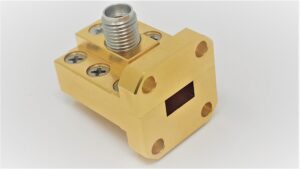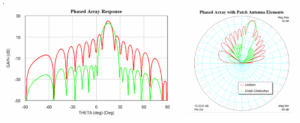Table of Contents
Design Structure
The design structure of Yagi and Omni antennas basically influences their functionality and performance across various applications. A typical Yagi antenna contains a number of elements, at least three: a driven element, a reflector, and one or more directors. These elements work together to focus the signal in a specific direction. The driven element is where the signal is fed into, and the reflector helps reflect the signal back toward the directors. Being parallel to the driven element of your antenna, the directors concenter this into a small beam. Out of this comes a truly directionally operated antenna with good signal gain and a long propagation effect over considerable distance. The power gain for Yagi antennas averages within 7 dB to 12 dB, which indeed shows quite a great difference against the Omni antenna. For example, a Yagi antenna designed for UHF frequencies (around 900 MHz) can achieve a range of up to 50 kilometers under optimal conditions, with minimal interference. The increased gain, however, comes with a trade-off: the antenna’s radiation pattern is narrower, making it less suitable for applications requiring widespread coverage.
In contrast, the Omni antenna is designed with a simpler, single-element structure. Typically, it uses a vertical monopole or dipole that radiates the signal uniformly in a 360-degree horizontal pattern. This omnidirectional radiation pattern makes it ideal for applications where broad coverage is needed. The most common use of Omni antennas is in Wi-Fi routers and mobile networks, where signals need to be distributed evenly across a large area. The design ensures the signal is equally available from all directions. The typical gain of an Omni antenna is about 2.5 dB to 5 dB, much lower compared to a Yagi antenna. Despite the fact that the gain is relatively low, Omni antennas find their wide application in systems of short-range communication where wide-area coverage is a priority. For instance, a typical 2.4 GHz Omni antenna used in Wi-Fi routers offers up to 100 meters of coverage radius in open areas, while in urban environments, this figure drops drastically due to obstacles and interference.
One of the big differences in design is the physical size and mounting requirements: a Yagi antenna is generally much larger and requires more precise installation. Depending on the frequency, the Yagi antenna ranges; generally, a Yagi antenna for the 2.4 GHz band is between 1.5 meters to 3 meters in length according to the number of directors and reflector. This somewhat makes it larger in size for only outdoor installations, such as rooftops or poles, which makes it more inconvenient compared to an Omni antenna due to its much smaller dimensions and ease of installation. A typical Omni antenna used in Wi-Fi routers may be only 20 cm to 30 cm long and thus is perfect for smaller spaces or indoor applications. Due to their smaller size, Omni antennas are also less expensive, usually costing in the range of $10 to $50, depending on the quality and specific design. On the other hand, a good-quality Yagi antenna can cost from $20 to more than $200, depending on its frequency range, size, and application.
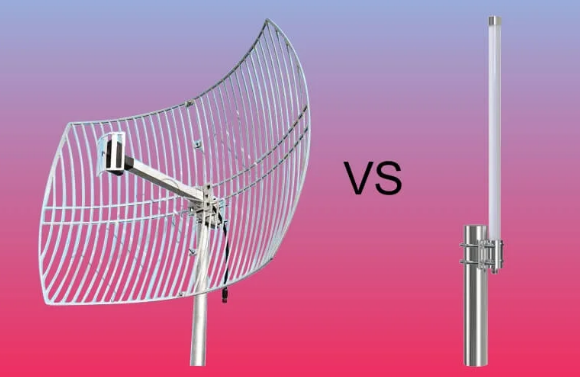
Radiation Pattern
The effectiveness of an antenna for different applications largely depends on the radiation pattern. Being directional, the Yagi antenna focuses its radiation in one direction, hence high gain and long-range communication. A Yagi antenna has a narrow radiation pattern, often with a beamwidth of around 30 to 60 degrees. This narrow beamwidth aids in concentrating the signal, making it ideal for point-to-point communications where the transmitter and receiver are in fixed positions. For example, a Yagi antenna intended for TV reception may have a beamwidth of approximately 45 degrees to focus the signal on a particular broadcast tower. This allows the antenna to receive signals from long distances, often up to 50 kilometers in rural areas where obstacles are minimal. The directional radiation pattern significantly reduces interference from unwanted sources, allowing the Yagi antenna to provide more reliable signals over long distances.
On the other hand, an Omni antenna radiates energy uniformly in all directions, providing a 360-degree horizontal coverage pattern. Such omnidirectional radiation is right for applications where broad signal coverage is necessary, as in mobile networks or hotspots in Wi-Fi. The radiation pattern of an Omni antenna normally contains a 360-degree beamwidth horizontally to ensure the signal is broadcast in all directions. However, this kind of broad coverage results in lower gain compared to the Yagi antenna. For instance, a typical 2.4 GHz Omni antenna will have a gain of around 2.5 to 5 dB, much smaller compared with the 7 to 12 dB that one can get with a Yagi antenna. An Omni antenna proves to be quite helpful for those situations in which the devices are either in movement or the location of the receiver is not a specific fixed point, for instance, cellular networks or even public Wi-Fi. Such cases see consistent signal coverage from the Omni antenna since the technology doesn’t require any proper alignment for it.
Another way it affects the working of an antenna is with respect to efficiency and performance in an environment. The Yagi antenna may have a narrow radiation pattern for a free-space scenario, enabling long-range communication; poor alignment of the antenna to the receiver degrades the performance. On the contrary, the Omni antenna, due to its uniform pattern of radiation, always guarantees more reliable service when the users are spread over a wide area. For instance, in a normal office building with a Wi-Fi network, an Omni antenna provides the devices on mobile with continuous connectivity as they move around the building. In such cases, the radiation pattern of the Omni antenna, though at lower gain, is better for overall coverage to ensure connectivity in all directions. A typical indoor Wi-Fi Omni antenna operating at 2.4 GHz can cover up to 100 meters in open space, while in the presence of walls and obstacles, it is possible to cover an area up to 30-50 meters.
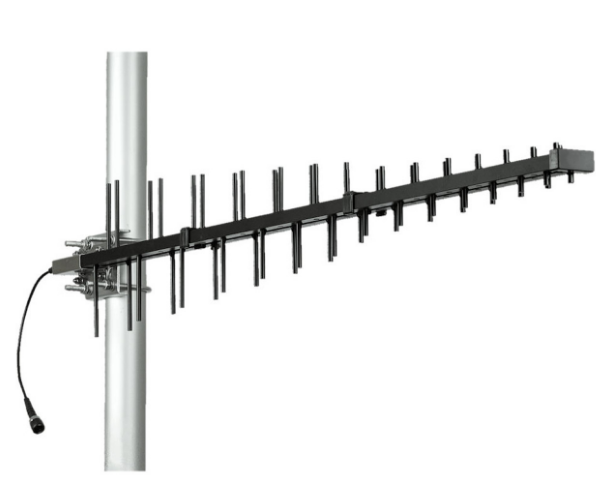
Beamwidth
Beamwidth is one of the important factors that determine the directional focus and coverage area of an antenna. In the case of a Yagi antenna, the beamwidth is usually narrow, which allows the antenna to focus its energy in a specific direction for greater signal strength and long-range performance. The beamwidth of a Yagi antenna can range from 30 to 60 degrees, depending on its design and frequency. The small beamwidth is important for applications requiring highly accurate signal transmission, like point-to-point communications or satellite links. A Yagi antenna operating at 2.4 GHz and with a 60-degree beamwidth may provide focused communication to distances as high as 50 kilometers over open terrain. As it emits within a narrow beam width, it can concentrate much energy in one direction; therefore, the strength of the signal in that particular direction increases considerably. Still, for it to work correctly with optimal performance, it should align as accurately as possible with the receiver.
In the opposite direction, an Omni antenna possesses a wide beamwidth, usually 360 degrees in the horizontal plane, giving it coverage on all sides. This wide beamwidth makes the Omni antenna ideal for those applications requiring uniform coverage, such as in Wi-Fi networks, cellular systems, and mobile communications. Large beamwidths are common for an Omni antenna; thus, while gain is spread over a wider area, it usually leads to low signal strength in a particular direction. For example, a normal 2.4 GHz Omni antenna can have a beamwidth of 360° horizontally and 30 to 60° in the vertical beamwidth with about 2.5 to 5 dB gain. While the gain is lower compared to a Yagi antenna, the wide beamwidth ensures that the antenna can provide continuous coverage in all directions, making it suitable for environments with multiple users or moving devices.
The beamwidth of an antenna directly affects its range and efficiency. A narrower beamwidth, like that of a Yagi antenna, enables the signal to travel farther because it focuses energy into one direction. This is very important for long-range communications, including satellite dishes and microwave links, where beamwidth would normally be as small as 15 to 30 degrees. A typical example is the Yagi antenna designed to operate at UHF frequencies of around 900 MHz, offering a beamwidth of 30 degrees and gain of up to 10 dB-sufficient enough to cover over 100 kilometers in open areas. This narrow beamwidth, however, results in rapid signal loss with misalignment of the antenna or if obstacles come in between the transmitter and the receiver. The wide beamwidth of an Omni antenna means it gives wider coverage with less signal strength in any direction. The beamwidth of the Omni antenna, while providing 360-degree coverage, results in a lower gain, typically between 2.5 dB and 5 dB, making it ideal for applications where constant, broad coverage is more important than maximum signal strength.
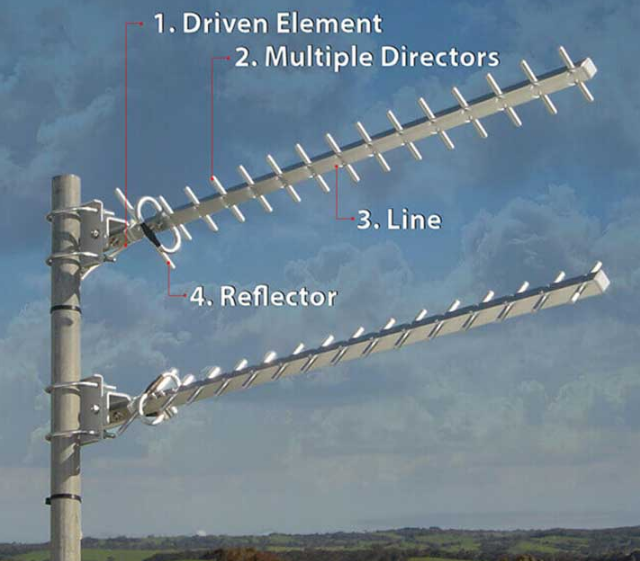
Range
The range of an antenna is perhaps its most key attribute, considering it forms a basis on which distance signals can travel from source to receiver. Yagi antennas, due to their being directional, have remarkably long ranges compared to the Omni antenna since they concentrate the signal in a specific direction. A Yagi antenna working at 2.4 GHz and having a 10 dB gain can have up to a 50-kilometer range in an open, flat terrain with very little interference. The narrower beamwidth allows the signal to be concentrated in a focused direction, hence longer ranges. On the other hand, if buildings, trees, or any other obstacles are thick in an area, then the range of a Yagi antenna can be reduced to approximately 10 to 20 kilometers since the focused signal becomes more vulnerable to attenuation from obstacles. This extended range makes Yagi antennas ideal for long-distance communication, such as wireless backhaul links or satellite communication.
On the other hand, Omni antennas provide more uniform signal coverage but at the cost of a shorter range. An Omni antenna operates with a 360-degree horizontal beamwidth and broadcasts its signal out in all directions. The typical range an Omni antenna has depends on factors such as frequency, gain, and environmental conditions. That usually means about a range of 100 meters in free space with the typical usage of a 2.4 GHz Omni antenna and a gain of about 3 dB. In heavy, or urban obstruction areas, like interference from a lot of walls, buildings, among other physical barriers, its range is depressed to possibly 30-50 meters. By a similar analogy, a conventional Wi-Fi router with an Omni antenna would be able to offer an area of 30 meters indoors and 100 meters outdoors in an open environment devoid of any obstacles. In return for this kind of wider coverage, one can say that the signal emanating from an Omni antenna is not as channeled in any direction as coming off of a Yagi antenna; it means reduced range.
Range is not solely determined by the design of the antenna; environmental factors such as terrain, obstacles, and interference also play a significant role in the effective communication distance. In rural areas with minimal interference, a Yagi antenna can achieve much longer ranges. For instance, a 900 MHz Yagi antenna, with a gain of 12 dB, gives the possibility to cover distances exceeding 100 km-even at sites with minimal features of terrain. On the contrary, an Omni antenna can hardly achieve such distance transmission, even at the same frequency. A 900 MHz Omni antenna with a gain of about 5 dB under the same conditions can reach about 1 to 5 kilometers, with the signal tending to weaken as it spreads out in all directions. This is because the range will mainly be different due to higher gain in the Yagi antenna and its ability to focus energy in one direction for a stronger, farther-reaching signal.
Gain
Gain is one of the most important parameters, which directly impacts the efficiency and power of an antenna. It is defined as the ability of an antenna to focus the radio signal in a particular direction, increasing the signal strength in that direction when compared with an isotropic radiator, which radiates uniformly in all directions. Yagi antennas are known for their high gain due to their directional design. An off-the-shelf Yagi antenna operating at 2.4 GHz with a gain of 10 dB can create a substantial boost in the signal strength in the direction it is pointed, making it quite suitable for long-range communications. This high gain makes it possible for the Yagi antenna to achieve up to 50 kilometers in open and unobstructed areas by directing most of the energy toward the receiver. On the other hand, for an Omni antenna of the same frequency with a gain roughly three times lower, 3 dB, it can barely cover a much smaller area at up to 100 meters in open space since its energy is equally distributed in every direction, making the power in one direction very weak.
Gain directly relates to the type and design of an antenna. The gain of a Yagi antenna increases with the number of directors. While a Yagi antenna with one or two directors can have a gain of approximately 7 dB, a more advanced Yagi antenna with six or more directors can achieve up to 12 dB gain. Gain is a measure of the antenna’s ability to focus energy in a certain direction, and the higher the gain, the farther it can travel. For example, a Yagi antenna at 900 MHz with a gain of 12 dB is theoretically able to transmit 100 kilometers or more in ideal conditions, whereas the range for a standard Omni antenna is considerably shorter. The trade-off, though, is that the Yagi antenna’s narrow beamwidth means it has to be very carefully aligned with the receiver to ensure optimal performance, whereas the Omni antenna sends the signal in all directions; thus, it gives pretty even coverage but with lesser gain.
In comparison, Omni antennas generally have lower gain due to their omnidirectional radiation pattern. The typical gain for an Omni antenna in the 2.4 GHz frequency range is between 2.5 dB and 5 dB, depending on the design and quality of the antenna. For example, with a 3 dB gain, the same 2.4 GHz Omni antenna covers a radius of 100 meters in an open area; this range significantly goes down in obstructed environments. Range from an Omni antenna will come down to 30 or 50 meters in conditions where walls, buildings, and interference characterize the terrain. While its gain may be considerably small, it makes up because of uniformity in service in every direction; omnidirectional antennas are hence very appropriate where devices around them happen to be always in mobile phase, examples of cellular base stations, or WiFi routers. The gain of an Omni antenna is spread across a 360-degree horizontal pattern, meaning that while it provides consistent coverage, it does so with less intensity in any given direction.
Applications
The common antennas used in so many systems include Yagi antennas and the Omni antennas, which operate optimally in differing areas due to their different characteristics. These are primarily chosen in communication systems that require long range and high directionality: for example, receiving signals for television from a broadcasting tower miles away. At 2.4 GHz, a regular Yagi antenna with a gain of about 10 dB can go up to 50 km in rural areas with least interference. This makes Yagi antennas ideal for applications requiring a strong and focused signal, such as wireless backhaul links between buildings or satellite communications. In these systems, the Yagi antenna’s narrow beamwidth allows it to concentrate the signal in a specific direction, ensuring high gain and minimal loss of signal strength over long distances. A Yagi antenna with a 12 dB gain at 900 MHz, for instance, could reach up to 100 kilometers in open terrain, making it invaluable for point-to-point communication in remote or rural areas.
By contrast, Omni antennas have a wide range of applications for which broad, uniform coverage is indispensable. The 360-degree horizontal radiation pattern of the Omni antenna makes them very suitable for providing consistent signal coverage in all directions. One common application of Omni antennas is in Wi-Fi networking, where it is desired to provide seamless coverage over a wide area. For instance, a 2.4 GHz Omni antenna with a gain of 3 dB will cover up to 100 meters in an open environment. In real environments, that is, with walls and other obstacles, the covered distance is reduced to about 30 to 50 meters. This makes the Omni antennas more suitable for indoor wireless systems, like a router or an access point, where devices keep moving around and the position of the receiver is not constant. Another application is found in the cellular communication towers where multiple Omni antennas are deployed over one cell site to blanket a wider geographic area with their combined coverage. Each antenna, therefore, serves a 360-degree sector in such installations and works together to provide widespread coverage of the network. Thus, as users move across an area, their connection will be maintained.
Omni-directional antennas are also found in on-vehicle systems, as in the use of GPS tracking or emergency communication applications. These antennas can offer continuous communication even when the vehicle is on motion because their omnidirectional nature ensures a good signal whatever the orientation the vehicle takes. For instance, in mobile radio communications, an Omni antenna can manage to hold a signal within a coverage of a few kilometers without breaking, even when moving at a high speed. While this low gain is a minus, Omni antennas make up for this with their broad coverage-an important factor when users or devices are in constant motion. Secondly, Omni antennas are quite popular in public safety systems where emergency services depend upon continuous, reliable communication as responders move across large areas. A typical application for such would be a 2.4 GHz Omni antenna featuring 5 dB of gain that could provide seamless communication in the most dense urban and countrywide settings.
Size
Antenna size is one of the important factors that determine its performance, the installation requirements, and application range. Normally, the Yagi antennas are much larger and more complex compared to the Omni antennas because of their directional design. The size of a typical Yagi antenna at 2.4 GHz will range from about 1 meter to 3 meters in overall length, with size being a function of the number of elements: reflector, driven element, and directors. A simple 2.4 GHz Yagi antenna could be approximately 1.5 meters long for a 10 dB gain; its elements are usually equally spaced for optimum performance. This larger size allows the antenna to focus energy in a narrow direction, providing higher gain for long-range communication. A 900-MHz Yagi with 12 dB of gain might conceivably cover as much as 100 km at an optimal condition; its bigger size, approximately 2.5 meters in length, does limit its easy portability, so Yagis with high gains work best for fixed installations: a wireless point-to-point link, a satellite dish, or a very long-range radio.
On the other hand, Omni antennas are significantly much smaller in size and more compact in design compared to Yagi antennas; this is because they work in Omnidirectional Radiations. A typical 2.4 GHz Omni antenna as used on Wi-Fi Routers and mobile communication would typically lie between 20 cm – 50 cm height while its diameter ranges from approximately 5 cm to 10 cm in size. The frequency and also the gain depend upon the size of the Omni Antenna. In comparison, an Omni antenna having 3 dB of gain on a frequency of 2.4 GHz may have a length of 25 cm with an approximate diameter of about 8 cm. This much smaller form factor allows Omni antennas to fit where a larger one would be a problem in consumer-grade uses, such as Wi-Fi routers at home. The omnidirectional antennas are often designed to be mounted on ceilings, walls, or poles and provide 360-degree coverage within a smaller area, hence highly suitable for applications where portability and ease of integration are critical.
The size of an antenna also plays a factor in its range and coverage area. Large antennas, such as Yagi antennas, are normally much more efficient at focusing energy in a specific direction, enabling them to achieve greater range. For instance, a 12 dB gain at 900 MHz can be less than 2 meters long and yield communication over a distance of more than 100 kilometers for Yagi antennas in rural clear areas. The size allows precise alignment necessary for long distance, point-to-point communications such as in rural wireless broadband systems or satellite ground stations. In contrast, smaller Omni antennas, due to their compact size, often have lower gain and limited range. A typical 2.4 GHz Omni antenna with a 5 dB gain may cover up to 100 meters in an open environment, but this range decreases in environments with walls, buildings, or other obstructions. The size of Omni antennas makes them suitable for short-range communication where signal uniformity and wide coverage are more important than long-range capability.

